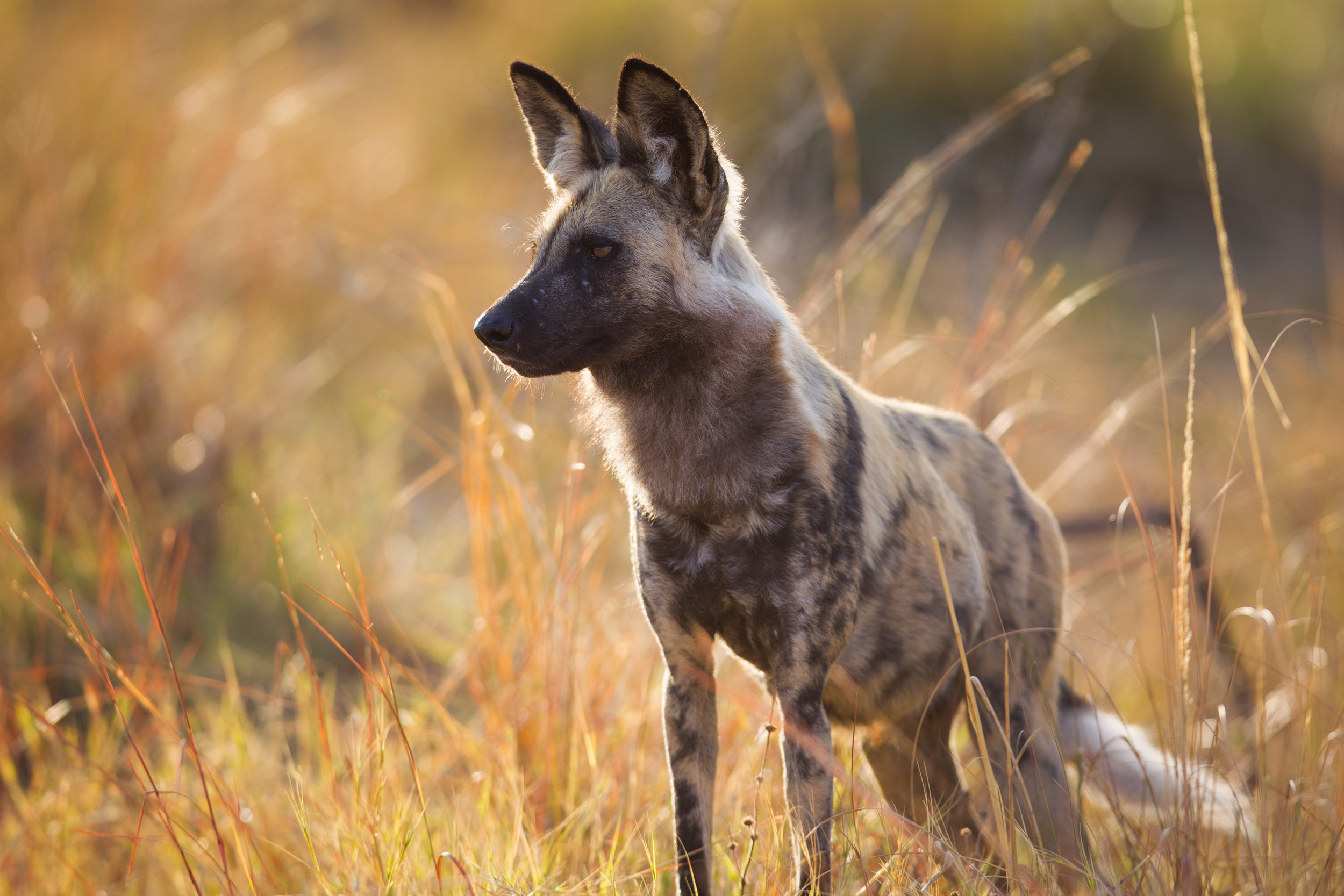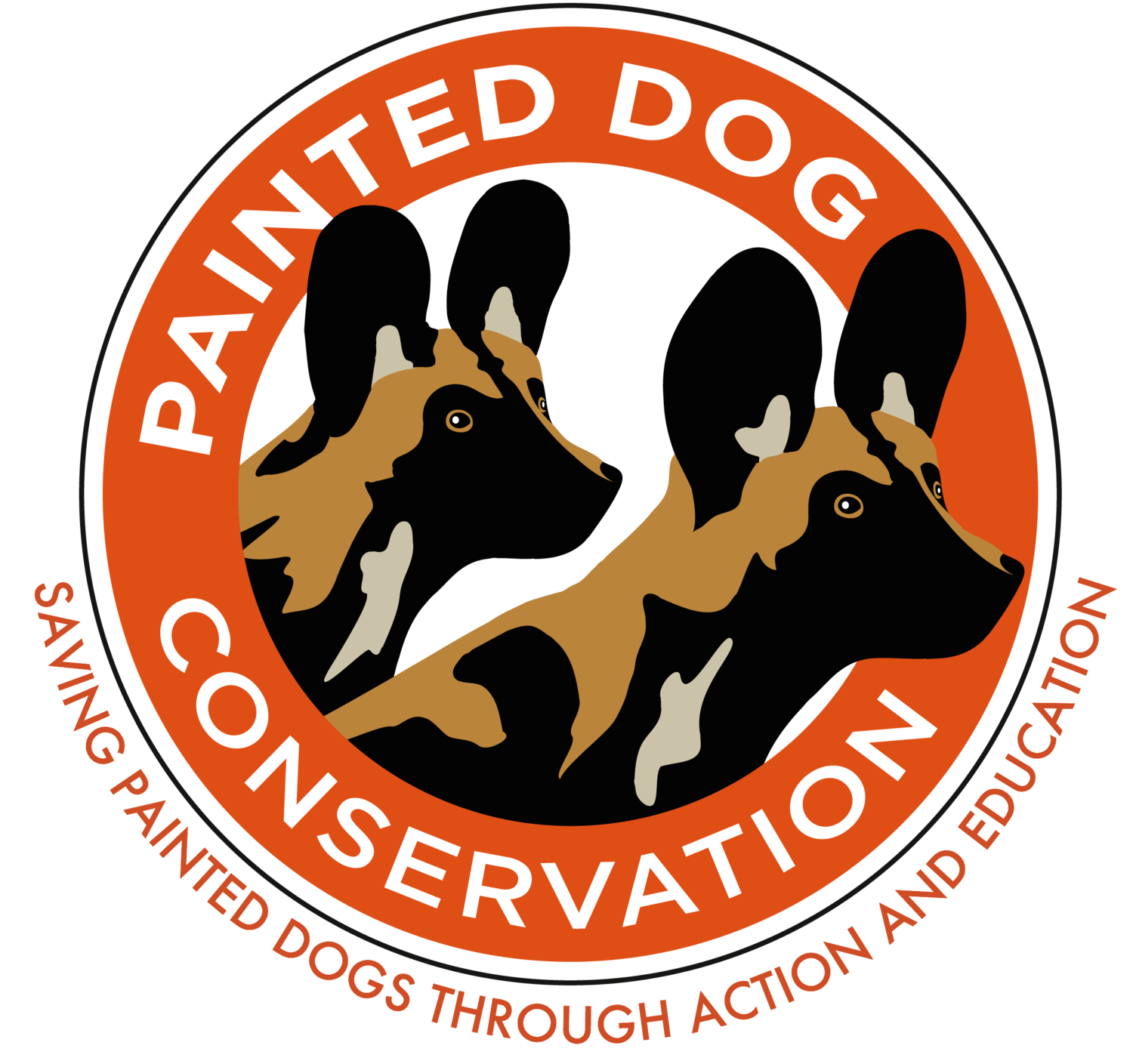
Frequently Asked Questions
FAQs about the painted dogs
Q. IS THE ALPHA MALE the BIGGEST MOST AGGRESSIVE DOG?
A. No the best word you can use to describe the alpha male (and female) is personality. They are born leaders and it’s this characteristic that makes them an alpha.
Q. Who is the top dog in the pack?
A. The alpha female is the top dog. The rest of the pack support her and provide for her pups.
Q. Can painted dogs breed with domestic dogs?
A. No they are too genetically distinct from domestic dogs, rather like human beings and baboons!
Q. Is a painted dog the same as a wild dog?
A. Yes. We like to use painted dog as the common name but the species has been given many common names, such as Cape Hunting Dog, Painted Wolf, African Wild Dog, or Wild Dog.
Q. For how many years do Painted Dogs live?
A. 7-9 years of age is typical in the wild, though with the threats of snares its unusual for us to see a 9 year old dog. In areas such as Mana Pools, where there are no snares, then the alpha females can live to 11 or 12 years.
Q. Do painted dogs attack people?
A. No. There has never been a case of painted dogs attacking people in the wild.
Q. How many paInted dogs are left? are they endangered?
A. Sadly, yes, very much so. Fewer than 7,000 painted dogs are left in Africa. They have disappeared from most of the countries in which they previously existed. Painted dogs are one of the most endangered animals in the wild.
Q. How many dogs are there living in Hwange National Park?
A. Hwange is one the last strongholds of painted dog population in Zimbabwe and Africa, with a total number of individuals upwards of 160 — and rising, thanks to conservation efforts of PDC.
Q. What do the dogs eat - both at the rehab centre and in the wild?
A. At the rehab centre we feed them cow and goat meat. In the wild, painted dogs’ especially enjoy duiker, kudu, and impala, and these make up 80% of their diet. Painted dogs are carnivores, meaning they only eat meat. They do not scavenge for food as hyenas do.
Q. Tell me more about what the dogs look, sound, and smell like!
A. Painted dogs have a strong musky odour, which is emitted from their entire body. They have beautiful, large, rounded, erect ears — this gives them a very acute sense of hearing. They only have four toes, unlike pet dogs which have a fifth toe (painted dogs are not related to domestic dogs). They also have different calls, some of which sound like birds. The most well known call is the "HOO" call, which can be heard from many kilometres away.
Q. What's the gestation period for a painted dog?
A. Painted dogs breed at the coldest time of the year which is typically May/June in Zimbabwe. After 69 to 72 days of gestation, the female pack leader, also known as the alpha female, gives birth to her pups.
How big are their litters?
Normally, only the leading female of the pack, also known as the alpha female, has pups — she can give birth to one litter of 2 to 18 pups.
How long do pups stay with their parents?
The alpha female gives birth in a den — a hole — to provide the pups with shelter and safety. The pups suckle for three to five weeks but after three weeks they start to eat solid food as well which the pack members regurgitate on demand. When the pups are about 12 weeks old, they will leave the den and follow the pack. At the age of two to three years the pups will leave the pack to form their own pack with other dogs from another pack and have pups themselves.
Q. Are they a kind of hyena? They look very similar.
A. No, although the two are often confused. The social structure, behaviour, and taxonomy of the two are very different. In fact, hyenas are more closely related to cats and mongooses than dogs. However, the two do come into contact; hyenas (and lions) try to steal food from the painted dogs, which then go hungry. Lions do not only try to steal food, they also kill adult dogs and their pups. Painted dogs eat very quickly so that other animals can’t steal their food — they can finish an impala in less than 10 minutes! The dogs share a kill without fighting, and pups always feed first.
Q. Do the dogs steal livestock from farmers?
A. No — the dogs prefer their natural food like impala, kudu, and duiker over cattle and goats. However, farmers do still shoot the dogs. We're working hard to change this cultural perception and help farmers and wild dogs live together harmoniously.
Q. How fast can the dogs run?
A. When they go hunting they can reach speeds of up to 65 kilometres (40 miles) per hour when chasing their prey!
Q. Are they diurnal or nocturnal?
A. Painted dogs are mainly active during the daytime. They usually hunt early in the morning or late in the afternoon. During the heat of the day they will rest in a cool and shady place.
Q. Where do painted dogs live?
A. Painted dogs used to be widely distributed; today they are only found in Zimbabwe, Tanzania, Botswana, and South Africa. Fewer than 700 dogs are left in Zimbabwe. Most of the Zimbabwean painted dogs live around Hwange National Park, the Zambezi Valley, and Gonarezhou. The dogs are not seen repeatedly in one place because they are nomadic; they have a home range as large as 750 square kilometres (466 square miles), and can cover 30 kilometres (about 19 miles) in a single day. The dogs live in groups called packs. Though packs can have as many as 49 members, because of poaching, only much smaller packs are seen.
FAQs about Painted Dog Conservation (PDC)
Q. How long has PDC been helping painted dogs?
A. Painted Dog Conservation (PDC) was founded in 1992. The aim of this project is to protect the painted dogs, also known as African wild dog, through action and education — this is even more crucial now, as the painted dog is facing extinction.
Q. How do you identify specific dogs in the field?
A. No two dogs have the same coat pattern, which makes it easy to identify them. What they do all have is tan markings with a black stripe on their head and a white patch at the end of their tail.
Q. I cannot help in person and am unable to make a donation, Is there any way in which I can help?
A. PDC tries to inform as many people as possible about the dogs. You can help simply by telling other people that painted dogs are endangered and facing extinction, and helping us spread the message. Follow us on our Facebook, Twitter and Instagram platforms and/or subscribe to our newsletter to get the latest news and share.
Q. How effective are the collars you use, and how much do they cost?
A. The Painted Dog Conservation project monitors the movement and number of packs. To follow the dogs, we fit them with protective retro-reflective collars. These VHF collars help us to efficiently and effectively monitor the dogs and locate them when responding to emergencies. A single collar costs about $800.
Q. How are poachers punished?
A. When our anti-poaching units catch poachers either in the field or by means of a tip-off, they effect a citizen arrest and hand the individual/s over to the Zimbabwe Republic Police (ZRP). The police then proceed to make the formal charge that leads to prosecution and conviction.
Q. Can I see the dogs at your Rehabilitation Centre?
A. Yes, if there are any at the given moment.
Q. How many dogs are at the rehab centre?
A. We cannot guarantee that any number of dogs will be present at the Rehabilitation Centre. We don’t intend to keep dogs there longer than needed; they are brought in for specific treatment that we cannot give them in the wild — hence the need to bring them in — but we release dogs back into the wild as soon as they recover, and as soon as possible.
Q. When can I visit either the pdc rehab facility or visitor centre? when are they open?
A. Our Visitor Center is open 7 days a week from 8am-5pm. Anyone is welcome to walk in and learn about the dogs and the Hwange ecosystem under the guidance of a knowledgeable and experienced tour guide.
Q. Do you offer game drives to go and see the dogs in the wild?
A. We don’t offer these since we are a conservation organisation and not a tour operator.
Q. Why do poachers kill the dogs?
A. Unfortunately there are some people in Africa who illegally poach wild animals. Painted dogs get caught in their traps and snares and die a cruel and horrible death.
Painted dogs are incidental victims of these snaring/poaching activities. Poachers intend to kill antelopes, buffalos, and other wild animals either to feed themselves or to sell the meat and make money. The dogs also get caught in these traps and snares — hence our anti-poaching unit, which is dedicated to finding and removing the snares in the bush (and where possible arrest the perpetrators to prevent it from happening again).
Q. Why do you capture the dogs? Do you keep them permanently at your rehab centre?
A. When a dog is badly injured, we capture it and take care of it at our Rehabilitation Centre until it has recovered, then we release it back into the wild. We never keep a dog longer than needed and aim to release each and every dog as soon as we can. Sometimes, a dog's injuries are simply too great or complex for us to treat them in the field.
Q. I think I spotted a painted dog! What should I do?
A. If you are lucky and see painted dogs please report this to Painted Dog Conservation via email on info@painteddog.org or via any of our social media platforms (Facebook, Twitter, Instagram) or in person at our Visitors Center.
“Painted dogs are so easy to fall in love with, just one encounter is enough to change your life forever.”
DID YOU KNOW?
Painted dogs pups are born with a black and white coat. After five weeks some of the black patches of fur start to turn tan. By fourteen weeks the pups have most of the adult coat colours.
